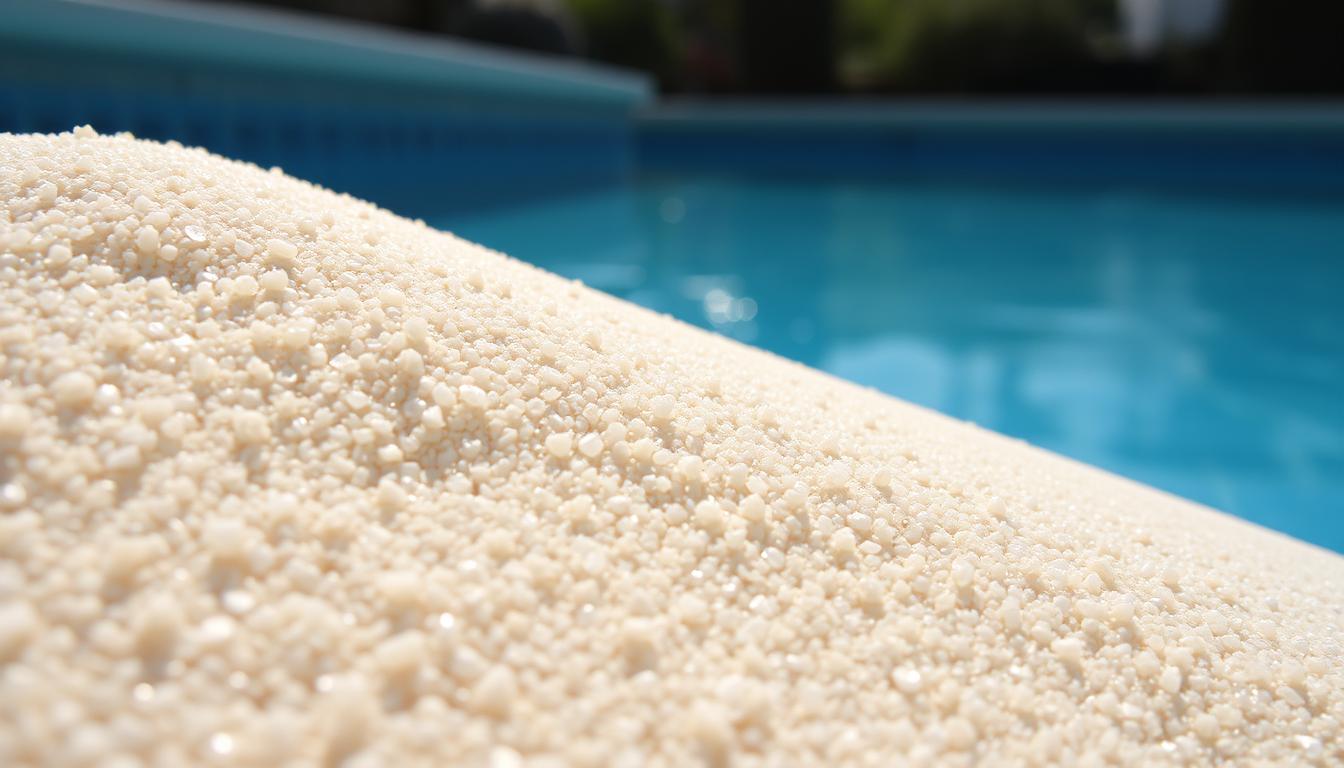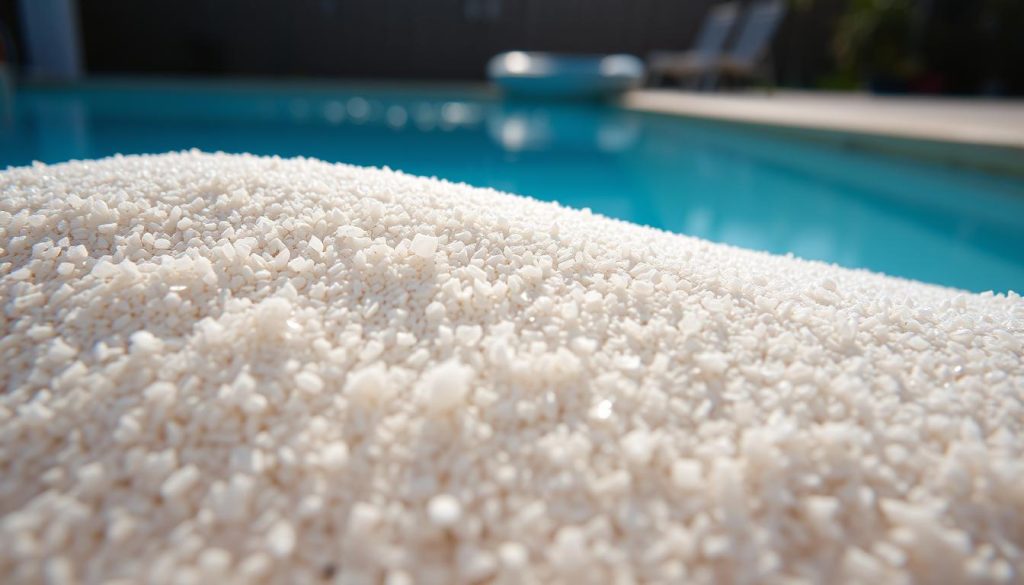
Pool filters with the right sand can trap tiny particles. Some as small as 3 microns, which is about 1/25,000 of an inch! Our experts have 40 years of pool industry experience. We’ve created this guide to help you choose the best sand for your pool filter.
Several options exist for pool filtration sand. These include silica sand, zeolite, and recycled glass. Each sand type has unique properties and benefits. Understanding these differences is key to making the right choice.
We’ll explore various pool filter sand types and their characteristics. We’ll also look at their advantages and top-rated products. This information will help you pick the perfect sand for your pool filter system.
With the right choice, you’ll enjoy a clean, healthy swimming environment. Your pool will stay crystal-clear for years to come.
Understanding Pool Filter Sand
Pool filter sand is key for clean, clear pool water. It’s vital to know the sand types and their benefits. This knowledge helps us make smart choices for pool upkeep.

Types of Sand for Pool Filters
Several sand types are used in pool filters. Each has unique traits and perks:
- Silica Sand: This is the most common pool filter sand. It’s cheap and good at trapping dirt. Silica sand is a natural, granular material graded for pool filters.
- Glass Balls: These are made from recycled glass. They filter better and last longer than silica sand. Glass balls are eco-friendly and need fewer replacements.
- Zeolite: This natural mineral can replace silica sand. It filters better, trapping smaller bits for clearer water. Zeolite also lasts longer, needing fewer replacements.
Benefits of Using the Right Sand
The right pool filter sand offers key benefits:
- Optimal filtration: It traps dirt and debris well, keeping pool water clean.
- Extended filter life: High-quality sand helps your filter system last longer. It reduces the need for repairs or replacements.
- Reduced maintenance: The right sand makes your filter work better. This means less backwashing and upkeep, saving you time.
- Cost-effective: Good sand can save money long-term. It needs fewer replacements and lowers the risk of filter damage.
| Filter Size | Sand Replacement Frequency |
|---|---|
| 16″ – 21″ (Above Ground) | Every 2-5 years |
| 24″ – 36″ (Inground) | Every 5-7 years |
Choosing the right sand for your pool filter is a crucial decision that can significantly impact the performance and longevity of your pool’s filtration system.
Knowing sand types and their perks helps you choose wisely. The right pick keeps your pool clean and your filter running smoothly.
Choosing the Best Sand for Your Pool Filter
Picking the right pool filter sand is vital for a clean, healthy swimming pool. The sand type and size affect your filter’s efficiency and water cleanliness. Let’s explore factors for choosing the best pool filter sand.
Factors to Consider
Consider your pool size and filter model when buying pool filter sand. Check your filter’s manual for the recommended sand amount. This varies based on filter diameter and brand.
A 24-foot pool filter usually needs about 250 pounds of sand. A 16-inch filter may require around 100 pounds. Fill your filter tank two-thirds to three-quarters full of sand for effective cleaning.
Sand size is crucial for pool filters. Grains are typically .45 to .55 millimeters in size. Specialty sand like Mystic White offers higher filtration efficiency and less frequent changes.
Top-Rated Pool Filter Sands
Consider these quality options when shopping for pool filter sand:
| Brand | Type | Filtration Size | Longevity |
|---|---|---|---|
| HTH | Silica Sand | 20 microns | 3 years |
| Mystic White | Silica Sand | 3 microns | 3-5 years |
| Palmetto | Silica Sand | 20 microns | 3-5 years |
| Zeo, Inc | Zeolite Sand | 5 microns | Up to 5 years |
| Harsco Metals & Minerals | Glass Sand | 5 microns | 3-5 years |
Silica sand is the most common type for pool filters. Zeolite and glass sands filter particles as small as 5 microns, improving water clarity.
Each bag of pool filter sand typically contains 40-50 pounds for the best value. Consider this when calculating the amount needed for your filter.
What Kind of Sand for Pool Filter
Choosing the right sand for your pool filter is vital. It affects water clarity and equipment health. Let’s explore pool filter sand and determine the ideal amount for your filter.
Pool Filter Sand Specifications
Optimal pool filter sand must meet specific criteria. It should be silica sand with 0.45mm to 0.55mm particles. The sand needs a uniformity coefficient under 1.75.
It must be free from impurities and contaminants. The sand should also be durable and resist crushing. This type of sand captures debris down to 20-40 microns.
Using proper sand keeps your pool water clean. Avoid cheap alternatives that may harm your filter system.
Amount of Sand Needed for Different Filter Sizes
The sand needed depends on your filter tank’s size and model. Most home pools need 100 to 200 pounds of sand. Here’s a guide for different filter sizes:
| Filter Size | Sand Amount (lbs) |
|---|---|
| 16-inch filter | 100-150 |
| 18-inch filter | 150-200 |
| 20-inch filter | 200-250 |
| 24-inch filter | 250-300 |
| 30-inch filter | 400-500 |
Using the right amount of sand is crucial. Too little leads to poor filtration. Too much can restrict water flow and strain your pump.
When in doubt, always consult your pool filter manufacturer’s guidelines for the recommended amount of sand specific to your model.
Proper sand use ensures a cleaner swimming environment. It also extends your filtration system’s life. Replace your pool filter sand every 3-5 years for best results.
Conclusion
Choosing the best sand for your pool filter is crucial for clear water. Sand filters need regular upkeep and sand replacement to work well. Above-ground filters need new sand every 2-5 years, while inground filters can last 5-7 years.
Consider sand type, filter size, and maker recommendations when picking filter sand. Use graded silicone quartz with 0.45 to 0.55-millimeter grains. This common media filters down to 20 microns.
Glass filter sand traps particles as small as 5 microns, great for algae issues. Zeolite sand, like Clinobrite, filters down to 10 microns.
Follow maker guidelines for sand maintenance and replacement. Backwash the filter monthly to remove trapped particles. Fill the filter about 2/3 full with sand.
If unsure about sand amount, check your filter’s manual. You can also ask a pool pro for help. Using the right sand ensures a clean, inviting pool.







